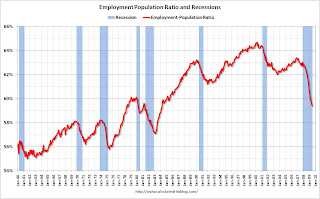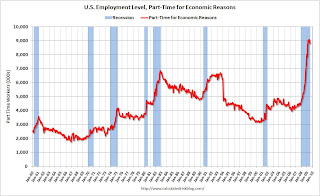by Calculated Risk on 8/07/2009 11:20:00 AM
Friday, August 07, 2009
Employment-Population Ratio, Part Time Workers, Average Workweek
Note: Several analysts follow the average workweek series to look for the end of a recession. The idea is that companies will increase the work week before they start hiring, so the average weekly hours might increase as a recession ends. The small increase in July will be viewed as a possible indicator. Other employment measures that are used to judge the end of a recession are the four-week moving average of initial unemployment claims (has fallen significantly) and the diffusion index (previous post).
A few more graphs based on the (un)employment report ...
Employment-Population Ratio Click on graph for larger image in new window.
Click on graph for larger image in new window.
This graph show the employment-population ratio; this is the ratio of employed Americans to the adult population.
Note: the graph doesn't start at zero to better show the change.
The general upward trend from the early '60s was mostly due to women entering the workforce. As an example, in 1964 women were about 32% of the workforce, today the percentage is close to 50%.
This measure fell slightly in July to 59.4%, the lowest level since the early '80s. This also shows the weak recovery following the 2001 recession - and the current cliff diving!
Part Time for Economic Reasons
From the BLS report:
The number of persons working part time for economic reasons (sometimes referred to as involuntary part-time workers) was little changed in July at 8.8 million. The number of such workers rose sharply in the fall and winter but has been little changed for 4 consecutive months.Note: "This category includes persons who would like to work full time but were working part time because their hours had been cut back or because they were unable to find full-time jobs."
 The number of workers only able to find part time jobs (or have had their hours cut for economic reasons) is at 8.8 million. This is slightly below the peak of 9.1 million in May.
The number of workers only able to find part time jobs (or have had their hours cut for economic reasons) is at 8.8 million. This is slightly below the peak of 9.1 million in May.Note: the U.S. population is significantly larger today (about 305 million) than in the early '80s (about 228 million) when the number of part time workers almost reached 7 million. That is the equivalent of about 9.3 million today, so population adjusted this wasn't quite a record.
Average Weekly Hours
From the BLS report:
In July, the average workweek of production and nonsupervisory workers on private nonfarm payrolls edged up by 0.1 hour to 33.1 hours. The manufacturing workweek increased by 0.3 hour to 39.8 hours. Factory overtime was unchanged at 2.9 hours.
 The average weekly hours has been declining since the early '60s, but usually falls faster during a recession. Average weekly hours in June was at the lowest level since the series began in 1964, and the uptick in July was very small.
The average weekly hours has been declining since the early '60s, but usually falls faster during a recession. Average weekly hours in June was at the lowest level since the series began in 1964, and the uptick in July was very small.Note: the graph doesn't start at zero to better show the change.
Earlier employment posts today:


